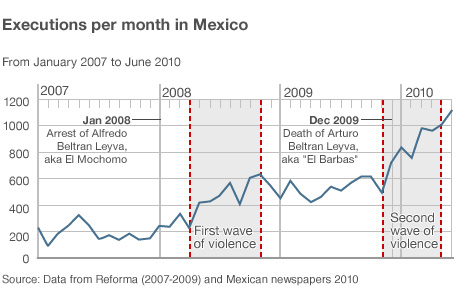
|  |  |  News Around the Republic of Mexico News Around the Republic of Mexico  
Drugs and Violence: Mexico's Addiction
 BBC News BBC News
go to original
September 03, 2010

Waves of killings blamed on drug cartels are continuing to sweep Mexico. Here, Mexican political scientist Eduardo Guerrero Gutierrez examines the reasons for the violence and the prospects for the future.

Drug-related violence in Mexico has killed nearly 30,000 people in the first 45 months of the current government, and its fast increase has been unstoppable.

If the killings continue to increase at the current rate that total will rise to about 75,000 by the time the government's term in office ends in December 2012.

The government's stance against the growing number of casualties in the war on drugs has been to emphasise the inevitability of violence.

In a recent interview, President Felipe Calderon said: "I wish there was less violence, but - being honest - that is not foreseeable in the short term, in which high levels of violence will remain. Violence will decline over the medium and long terms."

A particularly frustrating aspect of the government's war against organised crime is that - despite its high cost in terms of human lives - the war has not led to the decline of kidnappings, extortion and human trafficking.

In addition, frequent arrests of drug lords have had three highly detrimental effects: an increase in the number of criminal organisations (given the divisions that these arrests cause within a cartel); higher levels of violence; and territorial expansion of organised crime (which involves the invasion of new spaces).

Waves of violence

What are the main patterns of Mexican violence?

In general, it is a selective type of violence led by rival organisations and police and military authorities, driven by the chronic instability of criminal networks (to which the government has contributed significantly), and their ability to retain and win routes and territories for drug trafficking.

The violence is concentrated in a handful of cities: 20% of drug-related killings have happened in Ciudad Juarez; 36% in Juarez, Culiacan, Tijuana and Chihuahua, and 80% in 162 other municipalities (out of the 2,456 that exist in Mexico).

Nationally, there were two periods of dramatic and sudden increase in drug-related killings between January 2007 and August 2010: the first from April 2008 to November 2008, when killings rose from 200 to over 700 per month.



The origin of this first wave of violence was the arrest of Alfredo Beltran Leyva, aka El Mochomo, in January 2008. The arrest culminated in the separation of the organisation of the Beltran Leyva brothers from the Sinaloa Cartel in March 2008.

The second wave of violence happened between November 2009 and May 2010, when the number of killings went up from 500 to about 1,000 per month. This was driven by the death of Arturo Beltran Leyva, aka el Barbas, who was seized by the army.

Both of these big waves of violence were triggered by either an arrest or elimination of a cartel boss.

Mexican phenomenon

In all, violence increased in 21 of Mexico's 32 states during the first half of 2010.

In 12 states - which include the six northern border states of Baja California, Sonora, Chihuahua, Coahuila, Nuevo Leon and Tamaulipas - the growth of violence has been associated with the increased collaboration between gangs and cartels.

In Ciudad Juarez, for example, in Chihuahua state, the largest and most violent gangs (such as Barrio Azteca or Mexicles, with about 3,000 members each) are used by drug cartels to smuggle, import weapons, murder, extort and kidnap.

Frequent police action against gangs is often the decisive factor that pushes them to co-operate with the cartels, which offer them protection, among other benefits.

In areas of high gang violence Mexico could begin to adopt and to adapt the US experience in implementing anti-violence programmes. Some of those - such as Boston's Operations Ceasefire - in eliminating fire weapon crimes in gangland hotspots.

But in Mexico there are other types of violence that are not associated with gangs, which have distinct dynamics.

For example, in states such as Sinaloa, Michoacan and Durango violence is not linked to gangs, but to clashes between disciplined bureaucracies of gunmen engaged in transporting and guarding drug routes and territories.

Two cartels - Los Zetas and La Familia Michoacana - have the highest capacity for violence.

Los Zetas operate in 19 states and La Familia Michoacana in five, and share a common origin: the defection of Mexican elite military personnel in 1999.

Because of their preparation, methods of operation and equipment, these two criminal groups can only be dealt with effectively through military operations.

Mexican violence is a phenomenon with distinctive features in each region, linked to specific traits of drug cartels and the presence (or absence) of gangs.

Other variables that may change the local dynamics of violence depend on the type of activity the violent actor is involved with in the drug market, the extent of police corruption in the region, and the level of social collusion with organised crime.

All these factors should be addressed by any programme that seriously aims to stabilise or reduce violence in Mexico in the near future.
|

 |
|  |



